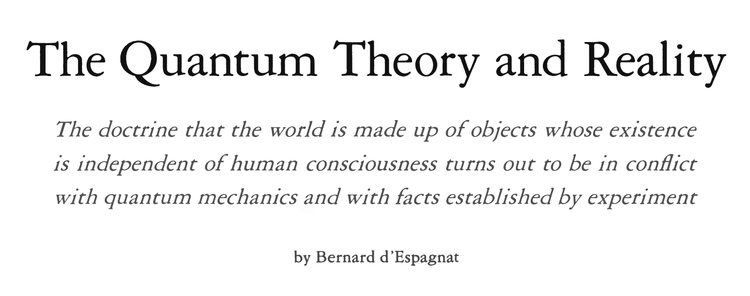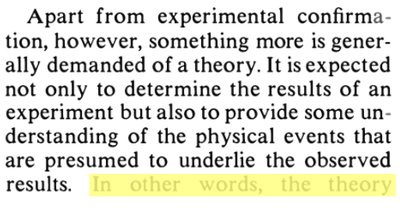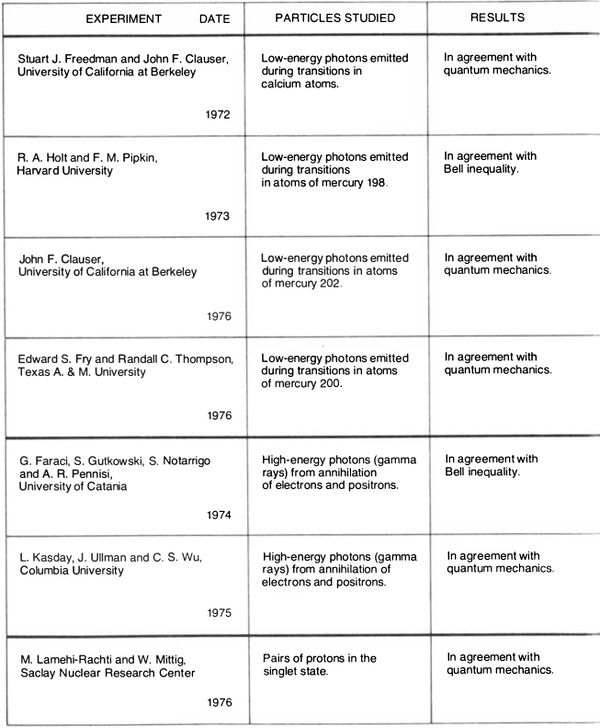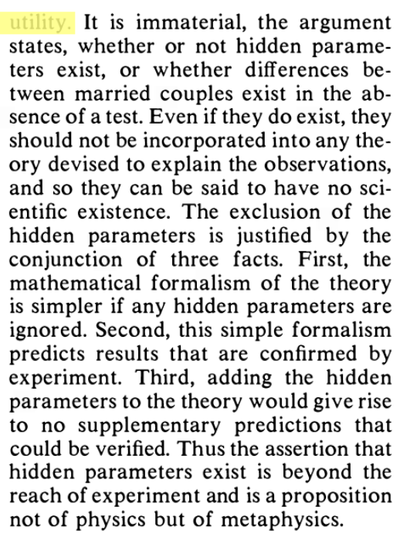m (Created page with "<center><wz tip="">750px</wz></center> <center><wz tip="">400px</wz></center> A metaphor is a...") |
m |
||
| Line 8: | Line 8: | ||
<center><wz tip="5 out of 7 in favour of QM, with furthermore much stronger support for QM than the ratio suggests, as discussed in the text.">[[File:espagnat79a-table-experiments.jpg|600px]]</wz></center> | <center><wz tip="5 out of 7 in favour of QM, with furthermore much stronger support for QM than the ratio suggests, as discussed in the text.">[[File:espagnat79a-table-experiments.jpg|600px]]</wz></center> | ||
| + | |||
| + | There is also, interestingly, comments on Aspect's experiment ''before'' it took place, showing that the result was well expected and that the shock came with the earlier works: | ||
| + | |||
| + | <center><wz tip="">[[File:Screenshot_20240108_120846.png|600px]]</wz></center> | ||
There is a derivation of Bell's inequality based on set-theoretic arguments, which is (even) more accessible than Bell's derivation.{{cite|bell64a}} The set theory aspect relies on the fact that a subset is smaller than the whole (and using this to derive inequalities). The quantum aspects enters with the fact that although one can not know two components of spin at the same time, if using two correlated particles and measuring, on each, one component of spin, due to the exact correlation in any basis, one can thus get the two components. That is, in a local realistic description. The equality derived is, indeed, violated by Bell states. | There is a derivation of Bell's inequality based on set-theoretic arguments, which is (even) more accessible than Bell's derivation.{{cite|bell64a}} The set theory aspect relies on the fact that a subset is smaller than the whole (and using this to derive inequalities). The quantum aspects enters with the fact that although one can not know two components of spin at the same time, if using two correlated particles and measuring, on each, one component of spin, due to the exact correlation in any basis, one can thus get the two components. That is, in a local realistic description. The equality derived is, indeed, violated by Bell states. | ||
Revision as of 11:10, 8 January 2024


A metaphor is attempted with married couples
There is a nice review, pre-Aspect, of the attempts to verify the EPR(B) correlations experimentally: seven experiments since 1971

There is also, interestingly, comments on Aspect's experiment before it took place, showing that the result was well expected and that the shock came with the earlier works:

There is a derivation of Bell's inequality based on set-theoretic arguments, which is (even) more accessible than Bell's derivation.[1] The set theory aspect relies on the fact that a subset is smaller than the whole (and using this to derive inequalities). The quantum aspects enters with the fact that although one can not know two components of spin at the same time, if using two correlated particles and measuring, on each, one component of spin, due to the exact correlation in any basis, one can thus get the two components. That is, in a local realistic description. The equality derived is, indeed, violated by Bell states.
An interesting argument highlighted is that even if hidden variables did exist, insofar as they are not needed (would not lead to different results), then they should be kept apart.

This maybe is an exaggeration since hidden variables would presumably remove the statistical character and lead to a fully deterministic theory (although it wouldn't have to). It would also probably clarify the ontological problems and it is difficult to imagine that additional variables would not lead to new verifiable experiments. But if it would be the case, the extra-variables could not be falsified, then indeed they would be as good as not existing.